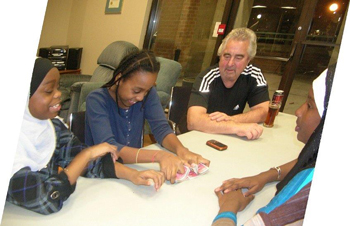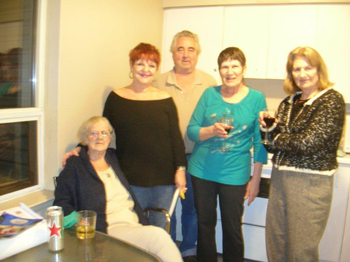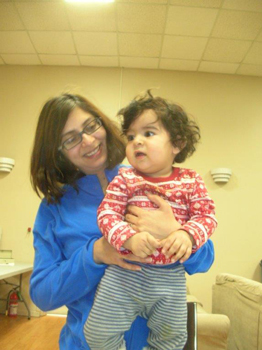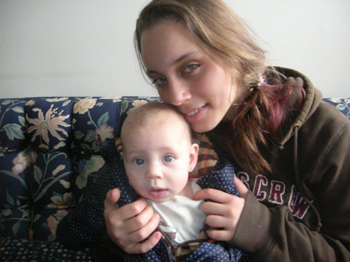Early beginnings
Rochdale England, a part of greater Manchester, is credited with being the founding site of the co-operative movement. In 1844 a store was established "to sell basic foods" and plans were made "to build a number of homes for members." (1) (2) Gradually co-operative housing projects have been established in many countries around the world. (3) (4)
Co-operative Organizations in Japan
Agricultural co-operatives functioned in rural Japan in the retail market as far back as the 1880s, then they ceased during WWII. During the occupation General Douglas MacArthur encouraged the co-operative movement. "A new cooperative law was passed in 1948, and the consumer cooperative movement was born again in Japan." Toyohiko Kagawa, a graduate of Princeton Theological School formed the Japanese Consumer Cooperative Union in 1951. In 2008, Thompson wrote that "Almost every farmer, fisherman, or forest owner is a member of a co-op." "Norinchukin, Japan's agricultural cooperative bank, is the 31st largest bank in the world with assets of $530 billion..." In addition, co-ops in Japan have been formed to deal with employing and housing doctors and their families, largely backed by trade unions and banks. University co-ops deal with student housing, supplies, food distribution, insurance and travel. There have been hard times because of the economic situation, earthquakes and tsunamis but the cooperative spirit is still a force in Japan. (3a)
Canadian History of Co-op Housing
Canada was introduced to co-op housing at the University of Guelph, Ontario back in 1913 by Guelph Campus Co-op Housing (1) and the concept gradually gained favour in parts of Canada.(4) (5) Joanne Bernard, Minister responsible for housing in the province of Nova Scotia said in a press release on January 23, 2015, "Co-ops are an important piece of the affordable housing mix,...Residents have access to stable, long-term housing, and they have a voice in how the co-operatives are governed." (6) In the 1970s the Federal Government and Provincial Governments of Canada developed legislation to form co-operative housing associations based on adapted international co-operative principles.(7) These associations are member-controlled (there is no landlord). Housing co-ops are usually apartment buildings or town-houses. Members living in the co-ops screen prospective members, but they are committed to accept people of different backgrounds, varied incomes and often people with special needs. Since they are non-profit, they offer more affordable housing. Those funded by the Federal Government worked through a government agency to guarantee the mortgage and provided subsidy, a sum of money to be used to top-up the housing cost of members with low incomes. The majority of members pay market rent (the actual cost of their housing).An example of the formation of a co-op and its present-day structure: Windward Co-operative Homes Incorporated
HISTORY - Planning for Windward Co-op began in 1981 when the Federal Government, through a quasi-independent agency (the Harbourfront Development Corporation) proposed that a co-operative home be built on land at the foot of Bathurst Street. (This land was vacated when the Maple Leaf stadium was moved.) Through an operating agreement, signed with the Central Mortgage and Housing Corporation, a mortgage for a building and a 60-year lease on the land was granted to members who got together to form the association. The operating agreement (Federal Co-operative Housing Program 1986) spells out how the management of the co-op is administered and describes what financial assistance for subsidy comes from the government. Contractors submitted building plans and eventually contracts were approved and signed so that work began. By December, 1986 the tower and town houses of the yellow brick building was nearly complete, and members began to move into some of the 101 one to three bedroom units.
YEARLY FINANCIAL COSTS ASSUMED BY THE FEDERAL GOVERNMENT - 1) The government pays The Agency for Co-operative Housing to see that all the terms of the agreement are met and make recommendations concerning management and care of the building. 2) Through the agreement, the co-op receives yearly payments to subsidize some members whose incomes would not cover their share of the entire cost of housing. The amount, contributed from the government, is based on the mortgage payments and drops as the mortgage is paid off by members. Members of Windward voted to add a surcharge on all units, the money to be added to the subsidy fund, which became underfunded. Members receiving subsidy live side by side with members paying market rent. (The market rent, passed annually by the Board, is based on the full costs of the mortgage, expenses and maintenance.)
MEMBER BENEFITS - Presently Windward has 130 adult members and twenty-five children under the age of sixteen. Members benefit in the following ways: 1) They are members of the co-op, not tenants, and have the use of their units for the time of their residency, after which time the unit is available to another member. Thus members are assured long-term housing unless they break the co-op and federal agreement laws. 2) Each member has one vote and yearly elects a Board of Directors from its membership. The Board of Directors deals with management of the co-op including authorizing all spending and investing, hiring and overseeing three staff workers, passing and enforcing by-laws and policies. There is no landlord. 3) Members pass yearly operating and capital project budgets delegating how the Board will spend the money. They review the auditor's report assessing how the money was spent at the end of each year. 4) Members are expected to have a say in how the co-op is run by volunteering on committees, for example Finance Committee, Membership Committee, Landscape Committee, Snow Committee, Social Committee, Capital Projects Committee, Fire Safety Committee, Green Committee, Newsletter Committee, By-Law Committee, and Neighbourhood Committees. By buying services (such as electricity) and materials (such as refrigerators) in bulk, the costs are less. Since it is non-profit, it makes for more affordable housing.
MEMBER OBLIGATIONS - When joining the co-op, members are screened and promise to obey the co-op laws and terms set out in the federal agreement, to pay their housing charges on time, to attend General Member meetings, to volunteer and to respect the rights of others.
ASSISTANCE FOR MEMBERS WITH DISABILITIES - Windward is one of a few co-operative homes serving a number of members with disabilities. All common areas and several units in the building are wheel-chair accessible. Members requiring assistance with day-by-day living get help from an agency that supplies care-givers and cleaners. PACE is the organization serving around-the-clock care to ten clients at Windward. The Ontario government pays the salaries of twenty-five PACE staff workers and the rental cost of one office unit at Windward. Some Windward members receive this service while rearing their children at Windward.
Member responses to questions regarding benefits to children
"What's the benefit of raising your children in a co-op?" I asked several members of Windward Co-operate Homes.
Julian, a film and TV writer and producer, always on the go, said, "There's a saying, 'It takes a village to raise a child', and Windward Co-operative Homes Incorporated is a small, condensed village." He lives at Windward with his wife and two sons, age two and four.
Aeron, a writer and editor, said that she moved into the co-op because she wanted to be an active member of a community. "Shortly after moving in I could see that there were many unexpected ways in which my daughter, Julia, then twelve-years-old, was going to benefit from living in this community. Julia met two young girls living down the hall. Their mother quickly realized my daughter was mature for her age and employed her to babysit. Julia totally enjoyed the responsibility, and we felt secure knowing that I was just down the hall, if she needed any help while babysitting. Soon Julia was asked by others to babysit their children. This experience not only gave her a part-time income, it also allowed her to forge relationships with other adults and children in a safe community on her own. As I was a single parent, I valued the fact that she was learning to relate independently to other adults and saw that she valued their input regarding books, movies and conversations about politics and things that interested her."
Tina and Rick have lived in the co-op all of their married lives and have brought up a son, now age 21 and daughter, now age 17, in this community. They related the ways they find living in a co-op beneficial: neighbours know that both parents are working, so if their child has trouble when the parents aren't home yet, Tina and Rick know that a neighbour will look after their kid; their children mix easily with all ages of people and people of different backgrounds; children often find jobs such as running errands, babysitting or dog walking; parents exchange out-grown clothing; their son and daughter observe how adults assume responsibility in the community by serving on committees or doing kind deeds. "It's our volunteering that gets us acquainted with our neighbours and teaches the children responsibility," Tina said.
Ash wrote: "First, from a father's point of view, I would say: unlike condo living, the general attitude toward kids is extraordinary. And in fact, kids are welcome in every activity and event within the family-friend co-op. Kids love the green space (park next door) and the well designed courtyard area to play and explore learning. Above all they love the pot-luck Christmas dinners, the spring pancake breakfasts, and the regular Friday night dinners (free for kids), prepared by volunteers. I like the sense of social responsibility that is being displayed by these volunteers, which fosters understanding that people are responsible for serving the needs of their communities. Furthermore, when we socialize together, we have a chance to see our neighbours from a different perspective than they express in formal meetings, and we begin to know them and understand their points of view."

Girls play cards as Dave, Friday cook, looks on

The cooks, Dave and Nancy (center) with friends in Windward kitchen
Beba, who left the former Yugoslovakia twenty-five years ago during the war, said she valued the help neighbours gave to teach her children right and wrong. "And I tell kids who are misbehaving, 'Your mom and dad wouldn't want to know you are doing that (writing on the walls, for example)'." Children often think that their parents are old fashioned, have out-of-date values and they get reinforcement from a neighbour about what is acceptable behaviour.
"My neighbours helped with my daughters," K, a former model from Guyana, said. She explained that she had forbidden her two teenage daughters to invite their boyfriends into their apartment when she wasn't at home. She didn't realize that the boys had begun to join the girls in the corridor outside the door to their apartment. They'd congregate, drink pop, eat junk food and leave a greasy mess on the carpet. The boys, wanting to appear macho, would swear and entertain the girls with foul language. "I know because they try that when they visit and I'm home, but I don't allow it." The neighbours were tired of that behavior, so one neighbour invited S, her eldest, to come inside her apartment while the other kids were carrying on in the hallway. S could hear all the rough talk and was told that their mother might be brought before the Board of Directors if the girls continued to condone this behaviour with their friends. "Fortunately S told me what had happened. I grounded the two of them for a month. I knew those boys and I wanted to be around when they were here, but they soon dropped out of the picture." The co-op was helpful on another occasion, K said. She explained that when she had cancer and had to live on a disability pension to raise those girls, she was eligible for subsidy to her housing charges. That meant that she didn't have to move to a new neighbourhood where the girls would have an added insecurity about their living arrangements.
Gopika, mother of ten-month-old Roshi, who is on maternity leave, came to visit in my unit. She plopped down on the floor while Roshi, dressed in his sleep and play outfit, pulled himself to a standing position and entertained himself opening and shutting the door to a cupboard. Then he spied my pen and propelled himself on all fours to reach it. "His name means 'radiating light'," Gopika explained. He was certainly an adventurous baby. While living in an apartment in New York City earning her degree, she'd felt lonesome. No one said, "Hello," she said. She hadn't known much about co-operative living, but now she sees the benefits. She grew up in Calcutta where three generations of the family lived together in close quarters. She was used to having someone around all the time, and here in Canada she felt alone with her husband as her only adult contact. Then she began to attend activities and be invited to visit other families. She hopes that the mother-baby get-togethers where parents convene in our meeting room to visit while their children play together will be resumed. Gopika wants Roshi to be a Chuddy Buddy, grow up with the other babies who live in this co-op.

Gopika with Roshi
M became a mentor. When she was moving into her previous co-op home, D, a young lad, of about eight or nine volunteered to help her carry her supplies. Later she stopped by his apartment to thank him and discovered the mother stretched out on the couch asleep, the father non-existent. It was obvious that if the boy was to eat, he would be the cook even at that young age. D asked to borrow her "world books" (Encyclopedias). M continued to ask D to run errands for her. When he graduated from high school, he got a grant of two thousand dollars from the Toronto Development Centre, with which he purchased a truck and started a handy-man business. Then one day the truck broke down. He used some of his savings to buy "The Iliad, by a man named Homer." This young lad was obviously ready for higher education, and he moved to live with M while studying political history on scholarship at the University of Toronto. He's now a graduate with a job in the media. As a woman living with the use of a wheelchair, M values this friendship, which she says will last a life-time.
Sisters Maya and Sarah stopped in the entrance hall to tell me about co-op living. "I hear both of you helped to publish one issue of the Windward newspaper," I said. "Yes," Sarah, age eight, said. "I wrote that if you drop something, you should stop and pick it up and not just let it be there." Maya, age ten, spoke up. "I like this neighbourhood." She added that several friends play soccer with her. "I can't say that I'm good, but I've been playing for three years, and I really like to play." It was 7:30 and she'd just returned from evening practice at the social center across the park. She demonstrated her agility by doing a cart-wheel. Mother was nearby, maybe ready to get them home to do homework or off to bed. The school bus would pick them up early in the morning. I thanked the girls for their contributions, and they concluded the interview with a high-five.

Maya and Sarah
Brittany was on a shopping trip but stopped for a visit. Savannah, her five-month-old daughter, nested in a front-pack carrier. The baby, unafraid, but with big blue eyes taking in the new surroundings, was gently removed from the carrier and put down on the sofa. She smiled when her twenty-two-year-old mom smoothed the top of her head, now becoming velvety. "She might have reddish hair," Brittany said, "like her father's hair." Brittany described how she'd grown up in Windward. "We lived in an apartment facing the park. We'd play over in the park, and if Mom wanted me, she'd blow a whistle, and I'd shout up to her window where I was. I can't imagine growing up any other place." She told me that there are about four or five friends from those days who grew up here as kids and now raise their own families here. "I was an only child, but I'm going to have another baby. I don't want Savannah to grow up without a brother or sister." She explained how the baby had been born in her own bedroom, that she had walked back and forth in her apartment for sixteen hours with the midwife monitoring her progress. "Several of us have had our kids right here in our apartments. It's much better than a hospital." We talked about how she spends her time. Brittany is interested in old furniture. She likes to make things, using beads to make Dream Catchers like native Canadians use to ward off evil spirits. "Savannah likes to be nursed during the night. I try to keep her awake in the afternoon." She wasn't going to be successful that day. Baby's eye lids were getting heavy, almost too heavy to smile at the camera. Looking at the baby we each smiled. "I can't think of ever living any place else," Brittany said.

Brittany and Savannah
Other considerations
Co-operative Housing arrangements encounter some problems. Each co-operative home is an incorporated multi-million dollar business. Board members sometimes wish to offer social assistance to a neighbour, assistance that is not in the best financial interest of the co-op, and this has led to financial difficulties in several co-ops. Members may tend to look at the short term and neglect to carry out improvements (to the infrastructure, for example) in order to avoid housing charge increases. Thus, many co-ops are now in poor repair. Participation at meetings and on committees by members is only about 50%. However there is no record of the times members volunteer to carry groceries for a neighbour, cook for someone sick, drive the neighbor to the doctor, babysit, and help in other ways. Problems arising between members may be brought to the Board of Directors for resolution, but the resolution sometimes results in feelings of favouritism. Help with some of these problems is available. Through local chapters of the Co-operative Housing Federation of Canada (CHF Canada), courses are offered to teach members good management and problem-solving practices.
Conclusion
Co-operative housing across Canada has proved to be successful at allowing members direct participation in the management of their facility, for providing affordable housing and is an environment where people of differing backgrounds, financial means and physical abilities live together and help each other. The concept requires an initial backer, preferably the federal, provincial or city government, and should require further financial aid in the form of subsidy and infrastructure renewal. The province of Nova Scotia is an example of recent government support for co-op housing. The January 23, 2015 announcement: "Federal, Provincial Governments Announce Housing Co-operatives Funding," detailed plans to take money from the deferred federal contribution to the province of Nova Scotia for use in repairing or improving the co-op housing facilities in the province. This venture will benefit 4,300 households. Federal Justice Minister Peter MacKay described the co-op program, it offers "better access to secure, stable housing." It is "welcome news for the housing co-op community," said Opal Briton, a 23-year co-op member in Halifax, Nova Scotia. (6) Living in a co-operative home is like living in a small community where members pledge to help each other and the entire village of members with diverse backgrounds is enrolled in rearing the children. It would appear that co-operative housing is flourishing in Japan, and it would be interesting to hear more first-hand accounts of the Japanese experience.
References:
- 1. Cole, Leslie. 2000, 2015. "Housing Co-op History. Co-operative Housing Federation of Canada. http://www.chfcanada.coop/eng/pages2007/about_1_4 (Retrieved February 21, 2015)
- 2. "History of the Co-operative Movement." International Co-operative Alliance. http://ica.coop/en/whats-co-op/history-co-operative-movement (Retrieved February 21, 2015)
- 3. "Housing cooperative." Wikipedia. http://en.wikipedia.org/wiki/Housing_cooperative (Retrieved February 21, 2015)
- 3a. Thompson, David. 2008. "Japan:Land of Cooperatives," Cooperative Grocer Network #135 March-April, 2008. http://www.cooperativegrocer.coop/articles/2008-04-22/japan-land-cooperatives (Retrieved March, 2015)
- 4. The Co-operative Housing Federation of Canada.
http://www.chfcanada.coop/eng/pages2007/benefits_2.asp (Retrieved February 9, 2015) - 5. Windward Co-op. http://windwardcoop.ca/about-us/about-co-op-housing/ (Retrieved February 9, 2015)
- 6. "Federal, Provincial Governments Announce Housing Co-operatives Funding." January 23, 1015. Nova Scotia Housing. http://novascotia.ca/news/release/?id=20150123002 (Retrieved February 21, 2015)
- 7. "Co-operative identity, values & principles." ICA: International Co-operative Alliance. http://ica.coop/en/whats-co-op/co-operative-identity-values-principles (Retrieved February 21, 2015)



 Marlene Ritchie
Marlene Ritchie










